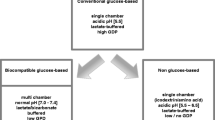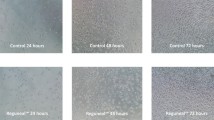Abstract
Amino-acid-based peritoneal dialysis (PD) fluids have been developed to improve the nutritional status of PD patients. As they may potentially exacerbate acidosis, an amino-acid-containing solution buffered with bicarbonate (Aminobic) has been proposed to effectively maintain acid-base balance. The aim of this study was to evaluate the mesothelial biocompatibility profile of this solution in comparison with a conventional low-glucose-based fluid. Omentum-derived human peritoneal mesothelial cells (HPMC) were preexposed to test PD solutions for up to 120 min, then allowed to recover in control medium for 24 h, and assessed for heat-shock response, viability, and basal and stimulated cytokine [interleukin (IL)-6] and prostaglandin (PGE2) release. Acute exposure of HPMC to conventional low-glucose-based PD solution resulted in a time-dependent increase in heat-shock protein (HSP-72) expression, impaired viability, and reduced ability to release IL-6 in response to stimulation. In contrast, in cells treated with Aminobic, the expression of HSP-72 was significantly lower, and viability and cytokine-producing capacity were preserved and did not differ from those seen in control cells. In addition, exposure to Aminobic increased basal release of IL-6 and PGE2. These data point to a favorable biocompatibility profile of the amino-acid-based bicarbonate-buffered PD solution toward HPMC.




Similar content being viewed by others
Reference
Wieslander AP, Kjellstrand PT, Rippe B (1995) Heat sterilization of glucose-containing fluids for peritoneal dialysis: biological consequences of chemical alterations. Perit Dial Int 15:S52–S59
ter Wee PM, van Ittersum FJ (2007) The new peritoneal dialysis solutions: friends only, or foes in part? Nat Clin Pract Nephrol 3:604–612
Park MS, Choi SR, Song YS, Yoon SY, Lee SY, Han DS (2006) New insight of amino acid-based dialysis solutions. Kidney Int Suppl (103):S110-S114
Selby NM, Fialova J, Burton JO, McIntyre CW (2007) The haemodynamic and metabolic effects of hypertonic-glucose and amino-acid-based peritoneal dialysis fluids. Nephrol Dial Transplant 22:870–879
Martikainen T, Teppo AM, Gronhagen-Riska C, Ekstrand A (2005) Benefit of glucose-free dialysis solutions on glucose and lipid metabolism in peritoneal dialysis patients. Blood Purif 23:303–310
Zheng ZH, Sederholm F, Anderstam B, Qureshi AR, Wang T, Sodersten P, Bergstrom J, Lindholm B (2001) Acute effects of peritoneal dialysis solutions on appetite in non-uremic rats. Kidney Int 60:2392–2398
Vychytil A, Fodinger M, Pleiner J, Mullner M, Konner P, Skoupy S, Rohrer C, Wolzt M, Sunder-Plassmann G (2003) Acute effect of amino acid peritoneal dialysis solution on vascular function. Am J Clin Nutr 78:1039–1045
Brulez HF, van Guldener C, Donker AJ, ter Wee PM (1999) The impact of an amino acid-based peritoneal dialysis fluid on plasma total homocysteine levels, lipid profile and body fat mass. Nephrol Dial Transplant 14:154–159
Feriani M, Passlick-Deetjen J, Jaeckle-Meyer I, La Greca G (2004) Individualized bicarbonate concentrations in the peritoneal dialysis fluid to optimize acid-base status in CAPD patients. Nephrol Dial Transplant 19:195–202
Stylianou E, Jenner LA, Davies M, Coles GA, Williams JD (1990) Isolation, culture and characterization of human peritoneal mesothelial cells. Kidney Int 37:1563–1570
Ksiazek K, Piwocka K, Brzezinska A, Sikora E, Zabel M, Breborowicz A, Jörres A, Witowski J (2006) Early loss of proliferative potential of human peritoneal mesothelial cells in culture: the role of p16INK4a-mediated premature senescence. J Appl Physiol 100:988–995
Witowski J, Topley N, Jörres A, Liberek T, Coles GA, Williams JD (1995) Effect of lactate-buffered peritoneal dialysis fluids on human peritoneal mesothelial cell interleukin-6 and prostaglandin synthesis. Kidney Int 47:282–293
Witowski J, Bender TO, Wisniewska-Elnur J, Ksiazek K, Passlick-Deetjen J, Breborowicz A, Jorres A (2003) Mesothelial toxicity of peritoneal dialysis fluids is related primarily to glucose degradation products, not to glucose per se. Perit Dial Int 23:381–390
Bender TO, Riesenhuber A, Endemann M, Herkner K, Witowski J, Jorres A, Aufricht C (2007) Correlation between HSP-72 expression and IL-8 secretion in human mesothelial cells. Int J Artif Organs 30:199–203
Witowski J, Korybalska K, Wisniewska J, Breborowicz A, Gahl GM, Frei U, Passlick-Deetjen J, Jörres A (2000) Effect of glucose degradation products on human peritoneal mesothelial cell function. J Am Soc Nephrol 11:729–739
Arbeiter K, Bidmon B, Endemann M, Bender TO, Eickelberg O, Ruffingshofer D, Mueller T, Regele H, Herkner K, Aufricht C (2001) Peritoneal dialysate fluid composition determines heat shock protein expression patterns in human mesothelial cells. Kidney Int 60:1930–1937
Schroder CH (2004) Optimal peritoneal dialysis: choice of volume and solution. Nephrol Dial Transplant 19:782–784
Schmitt CP, Haraldsson B, Doetschmann R, Zimmering M, Greiner C, Boswald M, Klaus G, Passlick-Deetjen J, Schaefer F (2002) Effects of pH-neutral, bicarbonate-buffered dialysis fluid on peritoneal transport kinetics in children. Kidney Int 61:1527–1536
Schaefer F, Klaus G, Muller-Wiefel DE, Mehls O (1999) Current practice of peritoneal dialysis in children: results of a longitudinal survey. Mid European Pediatric Peritoneal Dialysis Study Group (MEPPS). Perit Dial Int 19(Suppl 2):S445–S449
Nash MA, Russo JC (1977) Neonatal lactic acidosis and renal failure: the role of peritoneal dialysis. J Pediatr 91:101–105
Haas S, Schmitt CP, Arbeiter K, Bonzel KE, Fischbach M, John U, Pieper AK, Schaub TP, Passlick-Deetjen J, Mehls O, Schaefer F (2003) Improved acidosis correction and recovery of mesothelial cell mass with neutral-pH bicarbonate dialysis solution among children undergoing automated peritoneal dialysis. J Am Soc Nephrol 14:2632–2638
Schroder CH (2001) The choice of dialysis solutions in pediatric chronic peritoneal dialysis: guidelines by an ad hoc European committee. Perit Dial Int 21:568–574
Aufricht C, Endemann M, Bidmon B, Arbeiter K, Mueller T, Regele H, Herkner K, Eickelberg O (2001) Peritoneal dialysis fluids induce the stress response in human mesothelial cells. Perit Dial Int 21:85–88
Chang JM, Lin SP, Lai YH, Chen HC (2007) Effects of glucose-free dialysis solutions on human peritoneal mesothelial cells. Am J Nephrol 27:206–211
Yanez-Mo M, Lara-Pezzi E, Selgas R, Ramirez-Huesca M, Dominguez-Jimenez C, Jimenez-Heffernan JA, Aguilera A, Sanchez-Tomero JA, Bajo MA, Alvarez V, Castro MA, Del Peso G, Cirujeda A, Gamallo C, Sanchez-Madrid F, Lopez-Cabrera M (2003) Peritoneal dialysis and epithelial-to-mesenchymal transition of mesothelial cells. N Engl J Med 348:403–413
Riegel W, Ulrich C, Friedrichsohn C, Passlick-Deetjen J, Kohler H (1999) Liver cell reactive components in peritoneal dialysis fluids. Miner Electrolyte Metab 25:373–379
Plum J, Razeghi P, Lordnejad RM, Perniok A, Fleisch M, Fussholler A, Schneider M, Grabensee B (2001) Peritoneal dialysis fluids with a physiologic pH based on either lactate or bicarbonate buffer-effects on human mesothelial cells. Am J Kidney Dis 38:867–875
Chan TM, Leung JK, Sun Y, Lai KN, Tsang RC, Yung S (2003) Different effects of amino acid-based and glucose-based dialysate from peritoneal dialysis patients on mesothelial cell ultrastructure and function. Nephrol Dial Transplant 18:1086–1094
Zareie M, van Lambalgen AA, ter Wee PM, Hekking LHP, Keuning ED, Schadee-Eestermans IL, Faict D, Degreve B, Tangelder GJ, Beelen RHJ, van den Born J (2005) Better preservation of the peritoneum in rats exposed to amino acid-based peritoneal dialysis fluid. Perit Dial Int 25:58–67
Garosi G, Gaggiotti E, Monaci G, Brardi S, Di Paolo N (1998) Biocompatibility of a peritoneal dialysis solution with amino acids: histological evaluation in the rabbit. Perit Dial Int 18:610–619
Plum J, Fusshöller A, Schoenicke G, Busch T, Erren C, Fieseler C, Kirchgessner J, Passlick-Deetjen J, Grabensee B (1997) In vivo and in vitro effects of amino-acid-based and bicarbonate- buffered peritoneal dialysis solutions with regard to peritoneal transport and cytokines/prostanoids dialysate concentrations. Nephrol Dial Transplant 12:1652–1660
Martikainen TA, Teppo AM, Grönhagen-Riska C, Ekstrand AV (2005) Glucose-free dialysis solutions: inductors of inflammation or preservers of peritoneal membrane? Perit Dial Int 25:453–460
Steinhauer HB, Lubrich-Birkner I, Kluthe R, Baumann G, Schollmeyer P (1992) Effect of amino acid based dialysis solution on peritoneal permeability and prostanoid generation in patients undergoing continuous ambulatory peritoneal dialysis. Am J Nephrol 12:61–67
Reimann D, Dachs D, Meye C, Gross P (2004) Amino acid-based peritoneal dialysis solution stimulates mesothelial nitric oxide production. Perit Dial Int 24:378–384
Cuzzocrea S, Salvemini D (2007) Molecular mechanisms involved in the reciprocal regulation of cyclooxygenase and nitric oxide synthase enzymes. Kidney Int 71:290–297
Acknowledgements
The study was partially funded by Fresenius Medical Care.
Author information
Authors and Affiliations
Corresponding author
Rights and permissions
About this article
Cite this article
Bender, T.O., Witowski, J., Aufricht, C. et al. Biocompatibility of a bicarbonate-buffered amino-acid-based solution for peritoneal dialysis. Pediatr Nephrol 23, 1537–1543 (2008). https://doi.org/10.1007/s00467-008-0834-x
Received:
Revised:
Accepted:
Published:
Issue Date:
DOI: https://doi.org/10.1007/s00467-008-0834-x




